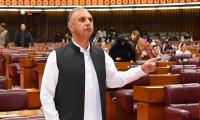What was it that prompted both China and India to react so furiously that a full-scale war was barely avoided? Though both countries are still at the brink of a war, the situation appears to be slightly improving.
Both countries possess two of the largest armies in the world. They are also trying to talk to each other about withdrawing their forces from the Line of Actual Control (LAC) but for the time being the tension seems to linger on. This problem has a much wider background than meets the eye. China has invested heavily in the entire region and has increased its influence substantially, which has scared India out of its wits. Ideally, India should have joined the recent initiatives by China and welcomed new projects that are beneficial for the entire region.
But sadly, India also behaves like Pakistan in the sense that it tries to equate with China as Pakistan tries to do so with India. It befits all countries to rightly assess their own strengths and weaknesses and rather than trying to outsmart each other they should be collaborating for the development of their people. That has not happened in the past more than 70 years and during this period each bigger country has tried to bully the smaller one, and the smaller one has tried to come at par with the bigger one. In this game, smaller powers have been on the losing side.
If India is not happy at Chinese investment in other countries, it can jolly well put forward its own investment plans; nobody is stopping it. But the Indian economy does not have that much potential, nor does it have a sound foreign policy to normalize relations with its neighbours. As a result, while China is implementing development projects from Burma and Bangladesh to Pakistan and Central Asia, India is still mired in its border disputes. If China is building bridges and ports from Asia to Europe, there is no need for India to feel restless. If China is transporting its goods to the world markets, India can also do it.
Instead, India started opposing China and did not respond positively to China’s diplomatic efforts too. That’s why it is important to look at the Ladakh imbroglio in its wider perspective. Essentially, it appears to be Indian jealousy against the Chinese big projects in the region. On the face of it, the present problem is over the valley of Gulwan, but it is not confined to it. There can be more than one interpretation of the current spat. The first is that India has challenged China in Ladakh because the Modi government has nothing to show to its people domestically.
Its economy is in shambles, growth is declining, and other promises also remain unfulfilled. The Covid-19 epidemic has been badly handled and the number of deaths has crossed the 20,000 mark. That’s why perhaps it was deemed imperative to divert the attention of the people of India to a far-flung area such as Ladakh. Suddenly, India expedited its construction of roads leading to the LAC towards China. Obviously, it was like throwing a challenge to China which considered it a threat to its own interests in the region. How could China tolerate a neighbouring country not only working against Chinese projects but also creating border problems for it.
Since China is working on huge infrastructure projects around the world, it can solve this small Galwan Valley problem militarily in no time. The ruling Communist Party of China (CPC) is much more organized than the BJP in India, and China appears to be prepared both militarily and politically. The CPC has shown tremendous progress in the past forty years since the 1980s. Though its focus has moved from communism to capital generation, this amalgamation of capitalism and communism has worked well to a great extent. China has trampled democratic rights but at least it has been able to fulfil the fundamental needs of the people.
It is worth recalling that in 2017 too, China and India stood face to face in the Doklam area where China was planning to build a highway into Bhutan. At that time, Bhutan came under pressure from India and asked China to stop the highway construction. If we compare China and India, we see that China has put to work a majority of its 1.44 billion people so that they can earn their livelihood; India is lagging far behind in this matter. A majority of Chinese people have come out of extreme poverty and a large middle class has emerged whose lifestyle is much better than that in India.
If qualified people from India are working all over the world, China is running big businesses across the globe. China finds employment for millions of youth every year, whereas in India due to a lack of quality education and skills most of the youth increase the number of the unemployed; or if they have good education they try to move out of the country. Looking with this backdrop it appears that the current conflict will be highly detrimental to India. Just imagine, in the middle of June 2020 dozens of Indian soldiers lose their lives and even more sustain serious injuries.
Chinese casualties were much smaller in number, though China has kept mum about it. For India, in the past nearly half a century this was the greatest loss of life outside a full war. Despite its border and political disputes with other countries, China has been sagacious enough to prioritize its economic interests by maintaining good trade relations with most countries. China considers Taiwan a part of China, but Taiwan is a separate country with which China has maintained thriving trade relations. Similarly, despite border disputes with India, China has increased its trade with India thirty fold since 2000 including trade in medicines and medical equipment.
After the current fracas in Ladakh, customs clearance has been slow and goods are stuck at Indian ports, but that is harming India even more. With the humiliation that India has faced in Ladakh, the opposition parties in India are also leveling accusations against the Modi government. One reason for that is the conflicting statements that the Indian government is releasing. The Indian ambassador in China said that India was working within its borders and China should not have taken steps on the ground level.
Then at an all parties’ conference on June 19, Prime Minister Modi blurted statements to the contrary. He claimed that nobody entered into Indian territory and all check posts were under the Indian control. In the same breath, he acknowledged that nearly two dozen Indian soldiers were killed in the border skirmishes. The question is: if China killed these soldiers within India, that means India could not defend its borders; and if they died in China, that means India violated the LAC. Such statements have made India a laughing stock. It is worth recalling that in 1962, China and India fought a full-blown war in which China roundly defeated India and occupied the disputed Aksai Chin region.
India finds itself in a similar bind now; it can neither risk a full war nor stop all trade with China because India benefits from it immensely. If trade stalls India will not be able to easily recoup the losses. And in case of war, India may lose more of its territory to China, while Indian nuclear arsenal may not be of much help. If war breaks out, even the US is not in a position to help India much. Despite tall claims of friendship, Modi will not be able to drag the US into the war.
To be concluded
The writer holds a PhD from the University of Birmingham, UK and works in Islamabad.
Email: mnazir1964@yahoo.co.uk
It is disturbing to note that anti-tobacco NGOs in Pakistan remain silent on tax evasion in tobacco sector
Focus on growth alone, while ignoring root causes of persistently high structural poverty, undermines growth itself
Pakistan faces dual task of providing humanitarian support to refugees while ensuring safety of its citizens
ICJ has called 26th Amendment “a blow to judicial independence, the rule of law, and human rights protection”
Financial mismanagement, especially during tenure of PTI government, pushed country into abyss of heavy debt
Women are half of world’s population, but underrepresented in politics, decision-making, and leadership roles







